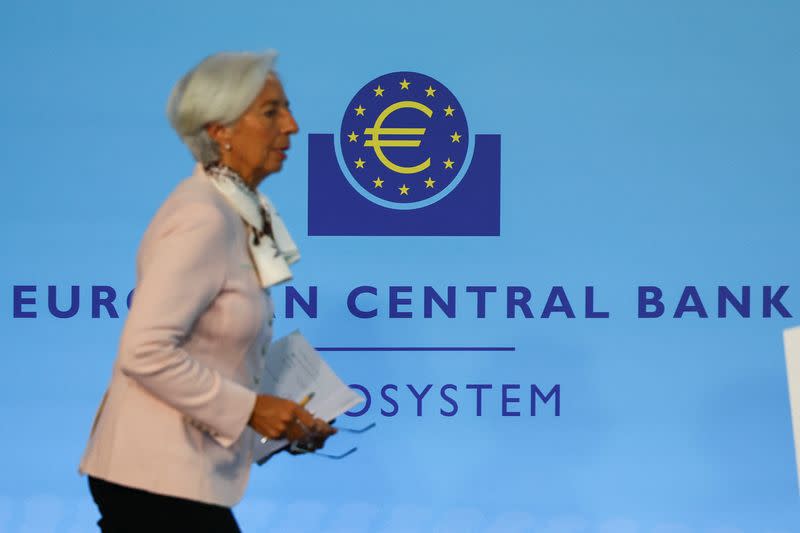Analysis-What rate hike? Investors eye ECB rate cuts as economy weakens

By Yoruk Bahceli and Naomi Rovnick
(Reuters) - Traders are standing firm on bets that the European Central Bank will cut interest rates next year, challenging the bank's "higher rates for longer" signal in the face of a souring economy.
The European Central Bank raised its key rate to a record 4% on Thursday and revised up its inflation forecast for next year, but with the euro zone economy in the doldrums, it signalled that the hike was likely its last.
Traders cheered the expected end of rate hikes that have raised borrowing costs from minus 0.5% in just over a year. That sent euro zone government bond yields tumbling, the euro down and stocks higher.
Italian government bonds, a proxy for euro area risks, led the rally. Benchmark 10-year yields fell as much as 15 basis points (bps) and were set for their biggest one-day drop in three weeks.
"The consensus is that this was a dovish hike, the last one and it's clear skies from here," said Charles Diebel, head of fixed income strategy at Mediolanum Asset Management.
The decision had been on a knife edge as policymakers and investors had to balance still-sticky inflation with a deteriorating euro area economic activity.
Inflation concerns ultimately won out at the ECB, but for traders, growth seems the bigger concern as they stood firm with their bets on rate cuts next year, expecting a first 25 bps cut by June.
The ECB cut its outlook for euro area growth this year to 0.7%, while economists polled by Reuters expect growth of 0.6%.
"There is a disconnect between market pricing and the levels of economic growth that the ECB expects," said Simon Bell, portfolio manager at Legal and General Investment Management, referring to rates expectations.
"If the market believed the ECB's growth forecasts it would not be pricing a mild recession."
The euro's 0.6% fall meanwhile was a further sign of investor concern with the growth outlook.
While bond and stock investors breathed a sigh of relief that further hikes were off the table, central to the ECB's message was also that rates would stay high for a "sufficiently long duration" to help bring down inflation.
"Taken at face value, what (the ECB) are saying tells us rates are up at a level that is going to be sustained for a while," Jason Simpson, senior fixed income strategist at State Street's SPDR ETF unit.
A market rally is also likely unwelcome to the ECB. A board member said in late August that markets rallying while the economic growth outlook weakened had undone some of the bank's monetary tightening.
"We think... market pricing will start reflecting (a higher for longer narrative) in coming days and weeks," said Anna Stupnytska, global macro economist at Fidelity International.
Key to the bond rally was also the ECB's pledge to continue reinvesting proceeds from the 1.7 trillion euro ($1.82 trillion) Pandemic Emergency Purchase Programme (PEPP) until the end of 2024. Those are crucial to the likes of Italian bonds as the ECB has more leeway to decide where it reinvests the proceeds.
"The removal of the threat of rate hikes is arguably a bigger benefit to Italy over Germany and equally important was no mention of messing around with asset purchases," Mediolanum's Diebel said, explaining the rally in Italian debt.
But the optimism may not last. Hawkish policymakers have started calling for an earlier end to PEPP reinvestments, and the ECB is likely to begin a debate on furthering its balance-sheet runoff with rate hikes likely done. Some analysts expect the ECB to curb or end PEPP reinvestments earlier.
Divyang Shah, strategist at LSEG's IFR Markets, said the markets not delaying expectations for rate cuts highlighted the scale of uncertainty over the policy outlook.
Indeed, ECB chief Christine Lagarde told reporters the bank did not say it had reached peak rates, and did not discuss what keeping rates high for "long enough" means.
"You have what is priced but (it's) hard to extend unless you make an assumption," Shah said.
(Reporting by Yoruk Bahceli and Naomi Rovnick; additional reporting by Dhara Ranasinghe; editing by Dhara Ranasinghe and Hugh Lawson)

 Yahoo News
Yahoo News 
